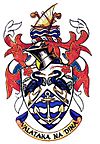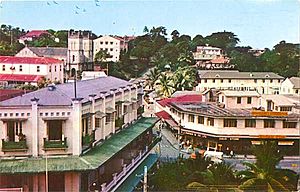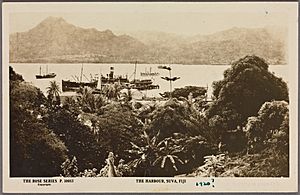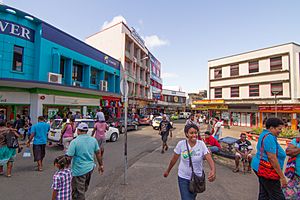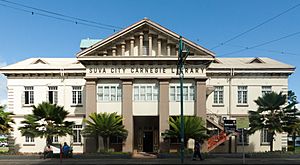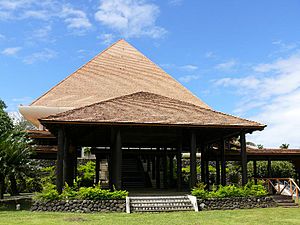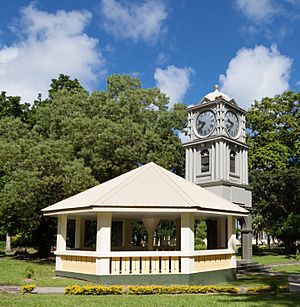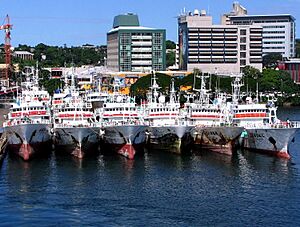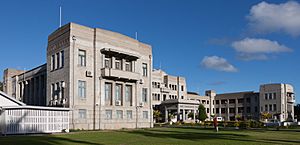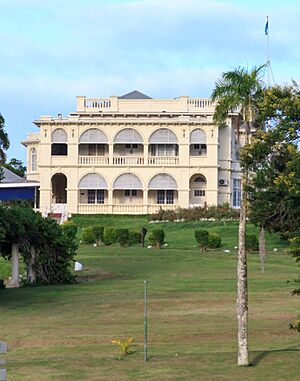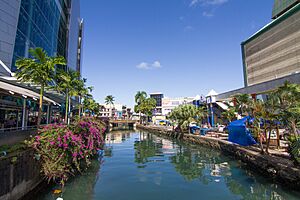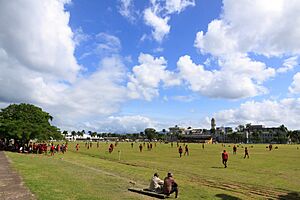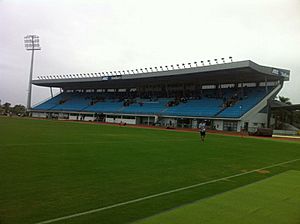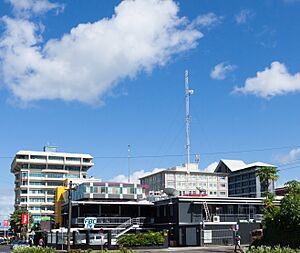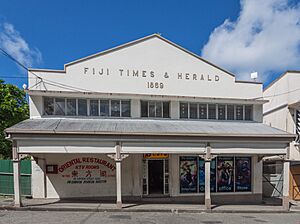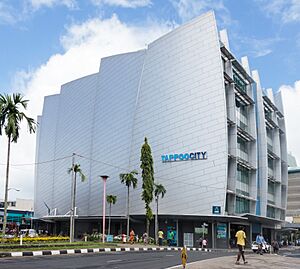Suva facts for kids
Quick facts for kids
Suva
सुवा (Fiji Hindi)
|
||
|---|---|---|
|
Suva Harbour, Central Business District, Government Buildings, WG Friendship Plaza Suva
|
||
|
||
| Motto(s):
Valataka na Dina (Fight for the Right)
|
||
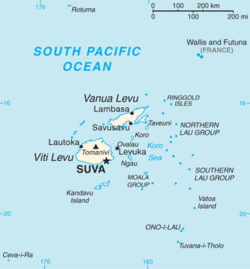
Suva within Fiji
|
||
| Country | ||
| Division | Central Division | |
| Province | Rewa | |
| District | Suva | |
| Government | ||
| • Type | Suva City Council | |
| Area | ||
| • Capital city | 26.24 km2 (10.13 sq mi) | |
| Population
(2017)
|
||
| • Capital city | 93,970 | |
| • Density | 3,581.2/km2 (9,275.2/sq mi) | |
| • Urban | 185,913 | |
| Time zone | UTC+12 (1200 GMT) | |
Suva is the capital and largest city of Fiji. It is located on the southeast coast of Viti Levu island. Suva is Fiji's main port and home to its biggest city area.
In 1877, Suva became the capital of Fiji. Before that, the capital was Levuka. Levuka was too small to grow because of the mountains and sea around it. So, the capital was officially moved to Suva in 1882.
In 2017, about 93,970 people lived in Suva city. If you include the nearby towns, the total population was around 185,913. The larger area, including Lami, Nasinu, and Nausori, had about 330,000 people. This is more than a third of all the people in Fiji!
Suva is very important for Fiji. It is the center for politics, business, and culture. It is also a key city for the whole South Pacific region. Many international companies and groups have their main offices here. Suva is also becoming known as a fashion hub.
Contents
History of Suva
Suva was a small village in 1868. A Fijian chief named Seru Epenisa Cakobau gave a large piece of land to a company from Australia. This was to help pay off debts to the United States. The company wanted to grow cotton, but the land was not good for it.
In 1874, the United Kingdom took control of the Fiji Islands. In 1877, they decided to move the capital to Suva. Levuka, the old capital, was too hard to expand. Colonel F. E. Pratt helped design the new capital in Suva. The move became official in 1882.
Suva became a municipality (a town with its own local government) in 1910. In 1952, Suva grew bigger by adding the Muanikau and Samabula areas. It officially became Fiji's first city in October of that year. Later, Suva also added Tamavua and Cunningham. Today, many suburbs have grown around Suva. Together, they form the Greater Suva Area.
Suva has hosted the South Pacific Games three times. The last time was in 2003. For this event, the Fijian government built new sports places. These included a gym, indoor sports center, swimming pool, and stadium.
Suva's Geography and Features
Suva is the capital, business, and political center of Fiji. It is also the main port city. You can see a mix of new buildings and old colonial ones.
Suva is on a hilly piece of land that sticks out into the sea. It is located on the island of Viti Levu. Mountains to the north and west bring a lot of rain all year.
Even though Suva is by the sea, it does not have sandy beaches. Its coast is covered with mangrove trees. The closest beach is about 40 kilometers (25 miles) away. A big part of the city center, including the Parliament buildings, is built on land that used to be mangrove swamps.
City Areas (Wards)
Suva is divided into five main areas called wards:
- Central: This is the city center. It has mostly businesses and shops.
- Tamavua: This area is mostly for homes.
- Extension: This area is partly urban and partly rural. It is mainly for homes.
- Samabula: This area has homes, factories, and shops. It even has its own small town center and a university.
- Muanikau: This area has mostly factories and homes. It also has big sports venues, a university, and places for fun.
Suva–Nausori Corridor
Suva is part of a larger city area called the Suva Urban Complex. This area includes Suva and three other towns: Lami, Nasinu, and Nausori. This whole area is home to over 330,000 people. It is the most populated part of Fiji.
Suva's Climate
| Weather chart for Suva | |||||||||||||||||||||||||||||||||||||||||||||||
|---|---|---|---|---|---|---|---|---|---|---|---|---|---|---|---|---|---|---|---|---|---|---|---|---|---|---|---|---|---|---|---|---|---|---|---|---|---|---|---|---|---|---|---|---|---|---|---|
| J | F | M | A | M | J | J | A | S | O | N | D | ||||||||||||||||||||||||||||||||||||
|
315
31
24
|
286
31
24
|
371
31
24
|
391
29
23
|
267
28
22
|
164
28
21
|
142
27
20
|
159
27
21
|
184
27
21
|
234
28
22
|
264
29
23
|
263
30
23
|
||||||||||||||||||||||||||||||||||||
| temperatures in °C precipitation totals in mm source: WMO |
|||||||||||||||||||||||||||||||||||||||||||||||
|
Imperial conversion
|
|||||||||||||||||||||||||||||||||||||||||||||||
Suva has a tropical rainforest climate. This means it gets a lot of rain all year round. There is no dry season. Suva gets about 3,000 millimeters (118 inches) of rain each year. Even in its driest month, July, it still gets about 125 millimeters (5 inches) of rain.
Temperatures in Suva stay pretty much the same all year. The average high is about 28°C (82°F), and the average low is about 22°C (72°F). Suva gets much more rain than the western side of Viti Levu. The rainiest months are from November to May.
People of Suva
Suva is a city with many different cultures and people. The main groups are Indigenous Fijians and Indo-Fijians. Many other groups also live here, like Rotumans, Europeans, and Chinese.
English is the most common language spoken. But people also speak Fijian, Fiji Hindi, and other languages. Suva is sometimes called the "New York of the Pacific." This is because so many different Pacific Island groups live here.
The University of the South Pacific has its main campus in Suva. This brings many students and workers from other Pacific Islands to the city.
Famous Places in Suva
The Suva City Carnegie Library is a well-known building. It was built in 1909 and is one of many old colonial buildings in the city.
Suva's government buildings are another important landmark. They were built on land that used to be a creek. The buildings were finished in 1939. In 1992, the parliament moved to a new building.
Government House is the official home of Fiji's president. It used to be where the British governors lived. The first house here burned down in 1921 and was rebuilt in 1928.
The University of the South Pacific (USP) has its biggest campus in Suva. It used to be a military base. USP is the largest university in the Pacific Islands outside of Hawaii.
The Fiji Museum is located in Thurston Gardens. It was started in 1904. The museum has the largest collection of Fijian artifacts in the world. It also studies Fiji's history, culture, and languages.
Suva has about 78 parks. The Takashi Suzuki Garden is a great place to watch the sunrise and sunset. Thurston Gardens has plants from all over the South Pacific.
You can find many shops in Suva. Cumming Street has been a lively shopping area for a long time. There are also modern shopping malls like Suva Central and TappooCity. TappooCity is one of the largest malls in the South Pacific.
Suva's Economy
Suva has grown to be the biggest and most advanced city in the Pacific Islands. It is a major business center. Many international banks have their main Pacific offices here, like ANZ and Westpac. Most of Fiji's financial groups and government offices are also in Suva.
A lot of Fiji's international shipping happens at Suva's Kings Wharf. This also helps Suva's tourism industry grow. Many cruise ships visit the city.
Walu Bay is Suva's largest industrial area. It has factories, warehouses, and shipyards. Other industrial areas include Vatuwaqa and Raiwaqa.
Suva has many busy markets and shopping areas. Cumming Street and Victoria Parade are popular places for shopping.
Important Organizations and Schools
Suva is home to more international and regional groups than any other capital in the Pacific Islands. Some of these include:
- The Fiji School of Medicine
- The University of Fiji
- The Fiji School of Nursing
- The University of the South Pacific
- The Fiji National University
- The Pacific Community (SPC)
- The Pacific Islands Forum Secretariat
- Greenpeace Pacific
- UNDP Headquarters for the Pacific region
- Asian Development Bank Headquarters Pacific
- World Bank Headquarters
Fun and Culture in Suva
Suva is a lively city for culture and entertainment in Oceania. It hosts many local, national, and regional events.
Event Locations
Suva has several large places for events:
- The Vodafone Arena can hold up to 5,000 people.
- The HFC Bank Stadium can hold up to 30,000 people.
- The FMF National Gymnasium Suva can hold up to 2,000 people.
- The Civic Auditorium can hold up to 1,000 people.
Parks and Gardens
Suva has many parks and gardens. Albert Park is famous for big historical events, like Fiji's Independence. Sukuna Park is a popular place for people to relax and watch performances. Thurston Gardens is the city's main botanical garden and home to the Fiji Museum. Many people also visit the Colo-i-Suva Forest Reserve to swim under waterfalls.
Music and Shows
Many concerts are held in Suva. Famous music artists like UB40 and Sean Kingston have performed here. Because people love Bollywood, many famous Indian singers and actors have also visited Suva.
Food in Suva
Suva offers many different kinds of food. You can find Fijian, Indian, Chinese, and American food. Fijians of Indian descent have created unique Fiji Indian curries.
Festivals
Suva hosts several festivals each year. The Hibiscus Festival is the biggest carnival in the South Pacific islands. There is also the New Years Street Party and the Fiji Show Case, which has carnival rides and performances.
Sports in Suva
Suva hosts many regional and national sports events, especially at the HFC Bank Stadium. The Coca-Cola Games, the world's largest high school athletics meet, is a special event. Suva has teams for rugby, netball, and football.
Suva hosted the first Pacific Games in 1963. It also hosted the games in 1979 and 2003. Suva has hosted the Pacific Games more than any other city.
News and Media
Suva is home to Fiji's main TV stations: Fiji One, FBC TV, and MAI TV. The Fiji Ministry of Information also produces government programs and news here.
The main radio stations, Fiji Broadcasting Corporation (FBC) and Communications Fiji Limited (CFL), are in Suva. They offer 12 national radio stations.
The two daily newspapers, The Fiji Times and The Fiji Sun, are printed in Suva. Many other weekly newspapers and magazines are also published here.
Shopping and Fashion
Suva is a great city for shopping in the Pacific. You can find shops clustered in an area called Suva Central. Cumming Street and Marks Street are good for clothes, jewelry, and electronics. Terry Walk and the Flea Market sell local crafts.
New, large shopping malls like MHCC and Tappoo City are also popular. Suva is also home to the Fashion Council of Fiji. The Fijian Fashion Festival, a big fashion event, happens every year in Suva.
Getting Around Suva

Nausori International Airport is near Suva. It mainly handles flights within Fiji, connecting Suva to Nadi International Airport. Fiji Link offers flights to places like Savusavu and Rotuma.
Suva has a public transport system with buses and taxis. These serve the city and nearby towns like Nasinu, Nausori, and Lami. Buses also connect Suva to other towns on Viti Levu.
You can take a ferry from Princess Wharf to Fiji's outer islands and Vanua Levu. International ships and cruise liners dock at Suva's Kings Wharf.
Famous People from Suva
Many well-known people are from Suva or live here:
- Petero Civoniceva (born in Suva), an Australian rugby league player.
- Nalini Krishan, an actress from the Star Wars films.
- Craig Parker, a New Zealand actor.
- Paulini (born in Suva), an Australian singer.
- Semi Radradra, a rugby league player for the Fiji national rugby league team.
- Waisale Serevi, a famous Fiji Rugby Team player.
- Jimmy Snuka, a professional wrestler.
- Sitiveni Sivivatu, an All Black rugby player.
- Lote Tuqiri, played rugby union for Australia.
Sister Cities
Suva is connected with these cities around the world:
 Beihai, China
Beihai, China Brighton, Australia
Brighton, Australia Guangdong, China
Guangdong, China Frankston, Australia
Frankston, Australia Port Moresby, Papua New Guinea
Port Moresby, Papua New Guinea Shaoxing, China
Shaoxing, China Yongsan, Seoul, South Korea
Yongsan, Seoul, South Korea Virac, Catanduanes, Philippines
Virac, Catanduanes, Philippines
See also
 In Spanish: Suva para niños
In Spanish: Suva para niños








